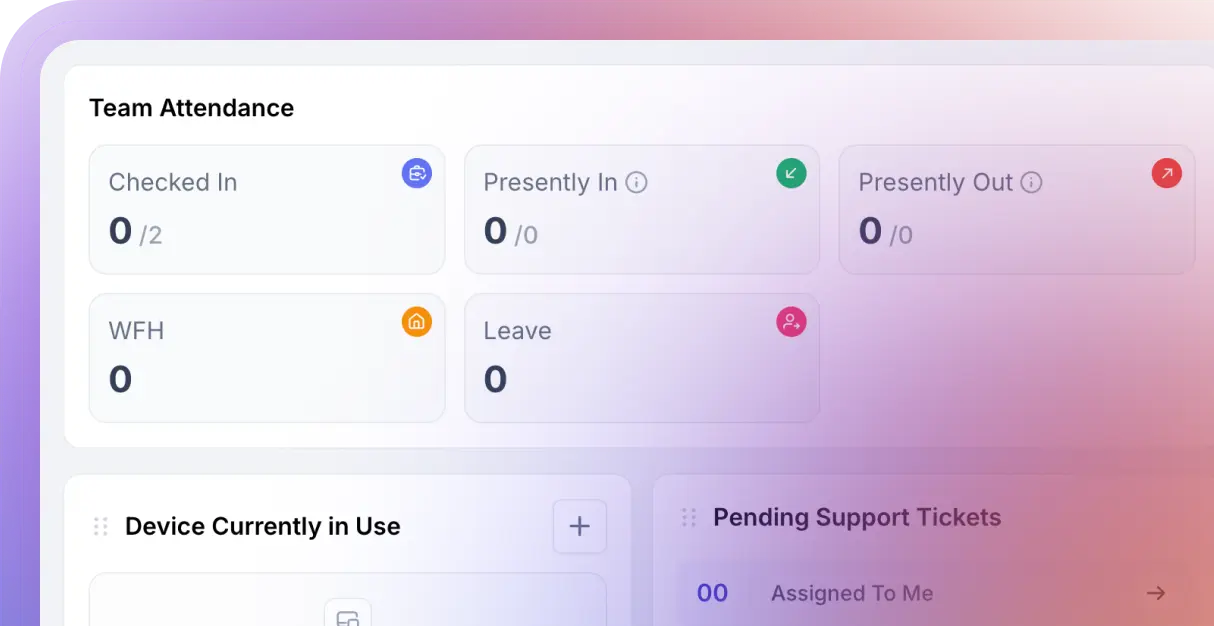Competitive advantage often hinges on one critical factor: how effectively organizations manage their talent ecosystem. While companies focus on innovation and market expansion, gaps in HR strategy and recruitment can quietly derail growth. Studies show that businesses with integrated talent management achieve 23% higher revenue per employee and a 31% greater market valuation than their peers.
When recruitment and onboarding lack strategic alignment, top talent leaves early, costing 2–3x their annual salary and delaying key initiatives. Research on fast-growing tech firms reveals the consequences: 47% longer time-to-market, 34% higher project failure rates, and a 53% spike in recruitment costs for specialized roles.
These mistakes hurt productivity, stall expansion and damage long-term growth potential. Our blog explores these critical HR and recruitment pitfalls in detail and shows how an HRMS can help you overcome them effectively. So, read further to save costs and hire the best talent.
Top 5 HR and Recruitment Mistakes to Avoid for Sustainable Business
Building a successful business requires a strong, well-managed workforce. Unfortunately, HR and recruitment mistakes can hinder business growth and create long-term challenges.
Here are five critical HR and recruitment mistakes to avoid for a thriving and sustainable business.
1. Ineffective Onboarding Process
An effective onboarding process sets clear expectations, equips employees with the required tools, and connects them to the company culture. On the other hand, a weak or disorganized onboarding experience can make employees feel unsupported, causing them to question their decision to join the company.
Signs of an Ineffective Onboarding Process
- Employees are unaware of their roles and responsibilities, and don’t know what to do on their first day or week.
- New hires didn’t receive adequate guidance or contact with their managers and teammates.
- New employees have too much information about the company. It makes them feel overwhelmed and puts the company’s privacy at risk.
- Once the initial orientation is over, new hires are left alone to navigate challenges on their own.
Understanding Ineffective Onboarding Process Better
A software developer joins a company and receives a generic orientation on company policies, but no specific guidance on the tools and technologies required for their role. As a result, they spend weeks figuring things out on their own, leading to significant delays in contributing to projects.
This extended onboarding period affects productivity and creates financial leakage for the company, as the resource takes much longer than expected to become fully operational, increasing costs and delaying deliverables.
Real-Life Example of Ineffective Onboarding Process
In 2017, an investigation led by former U.S. Attorney General Eric Holder revealed significant flaws in Uber’s onboarding process. The review found that new hires were not properly trained or aligned with the company’s cultural values and behavioral expectations, which contributed to instances of inappropriate conduct among employees.
How to Improve the Employee Onboarding Process?
- Send welcome emails outlining what new hires can expect during their first week.
- Provide role-specific training to equip employees with the knowledge and skills they need.
- Assign mentors or buddies to help new hires acclimate and answer questions.
- Schedule team-building activities to help new hires connect with colleagues.
- Take follow-up at regular intervals and solicit feedback to improve the onboarding process and address any concerns.
2. Incomplete or Missing Employee Documentation
Employee documents include records that ensure law compliance, facilitate smooth communication, and provide a reference point for decision-making in performance management and conflict resolution. Without proper documentation, businesses expose themselves to avoidable risks, such as disputes over employment terms, tax issues, or workplace safety incidents.
Consequences of Incomplete or Missing Documentation
- Non-compliance with labor laws can result in fines, lawsuits, or shutdowns.
- Disputes over wages, working hours, or job terms can escalate into costly legal battles.
- Without clear records, HR teams may waste time searching for missing documents or trying to reconstruct past actions.
- Employees may perceive poor record-keeping as a sign of unprofessionalism, damaging morale and trust.
Understanding Incomplete Documentation Better
An underperforming employee claims wrongful termination. The company lacks documented performance reviews or disciplinary actions to support its decision, increasing the risk of losing in court or paying a settlement.
Real-Life Example of Incomplete Documentation
Major IT companies like TCS, Infosys, Wipro, and DXC Tech collectively postponed onboarding for thousands of new hires over multiple recruitment cycles. The delays were often attributed to internal project uncertainties and prolonged paperwork delays, resulting in candidate frustration and operational disruptions.
How to Improve Employee Documentation Practices
- Use a checklist to ensure all required documents are collected during hiring.
- Implement HR management software to digitize and securely store records.
- Use tools with reminders for compliance deadlines, such as tax form submissions or certification renewals.
- Periodically review documentation for accuracy and completeness.
- Update job descriptions, contracts, or policies as rules and regulations evolve.
- Ensure HR personnel are well-versed in documentation requirements and legal standards.
3. Compliance Gaps
Compliance refers to adhering to the rules, regulations, and standards set by government agencies and industry bodies. These rules are designed to protect employees’ rights, ensure workplace safety, and uphold ethical business practices.
Not adhering to labor laws, health and safety standards, or employee rights is counted as one of the crucial HR and recruitment mistakes, as it exposes businesses to serious legal, financial, and reputational risks.
Common Compliance Gaps
- Failing to comply with minimum wage laws or overtime regulations.
- Misclassifying employees as independent contractors to avoid benefits or taxes.
- Inadequate safety measures lead to workplace accidents.
- Missing training records for equipment handling of hazardous materials.
- Hiring employees without verifying work authorization or proper documentation.
- Missing I-9 forms or equivalent employment eligibility documentation.
- Mishandling sensitive employee data, such as payroll or health records.
Understanding Compliance Gaps Better
A manufacturing firm does not provide adequate training for machinery use. A serious workplace accident occurs, leading to a worker injury and a hefty penalty from the regulatory body for non-compliance with safety standards.
Real-Life Example of Compliance Gaps
Alphabet, Google’s parent company, agreed to invest at least $500 million over the next decade to overhaul its global compliance systems. This was part of a settlement in a shareholder-led antitrust lawsuit and reflects the scale of investment required to address compliance deficiencies at enterprise levels.
How to Avoid Compliance Gaps
- Regularly review local, regional, and national labor laws and industry-specific regulations.
- Subscribe to updates from regulatory agencies or use compliance monitoring tools.
- Develop and communicate policies on wages, overtime, anti-discrimination, and harassment.
- Create an employee handbook detailing workplace rights and responsibilities.
- Periodically review payroll, safety measures, and compliance documentation.
- Use third-party audits to identify and address compliance gaps.
- Train HR staff, managers, and employees on legal requirements and compliance best practices.
- Use HR software to automate compliance tasks, such as tracking employee work hours or storing documentation securely.
4. Lack of Adequate Employee Training
Candidates today seek not only competitive salaries but also opportunities for growth, learning, and skill development. Failing to provide adequate training sends a message that the organization does not prioritize employee growth, which can deter high-quality applicants and lead to high turnover among new hires.
Common Recruitment-Related Training Gaps
- Job postings focus on responsibilities without mentioning training or career advancement.
- Insufficient role-specific training for new hires, resulting in confusion, slower ramp-up times, and early disengagement.
- Absence of structured training programs for internal employees, limiting promotion opportunities and increasing dependency on external hiring.
Understanding Inadequate Training Better
A retail company implements a new point-of-sale system but provides minimal training to new employees. As a result, staff struggle to operate the system, leading to long checkout times and customer dissatisfaction.
Real Life Example of Inadequate Training
A study of Wipro’s onboarding methods revealed that onboarding focused solely on company culture led to high turnover. When onboarding was redesigned around individual identity rather than generic orientation, turnover dropped by 32%, and customer evaluations improved significantly.
How to Address Training Gaps for Recruitment Success
- Include details about onboarding, training programs, and growth opportunities in job descriptions.
- Design onboarding programs that include both general orientation and role-specific skill development.
- Provide mentors or training buddies to support new hires during their initial months.
- Communicate clear career paths with training milestones during recruitment interviews.
- Offer certifications, workshops, or external training opportunities that enhance employees’ resumes.
5. Insecure Handling of Employee Data
In recruitment, handling sensitive candidate and employee data securely is a legal and ethical necessity. Mishandling this information is considered one of the biggest HR and recruitment mistakes, as it not only violates privacy laws but also damages your organization’s reputation, undermining trust with current employees and potential hires.
Common HR and Recruitment Mistakes Related to Data Security
- Storing resumes, application forms, or sensitive documents in unsecured systems.
- Collecting more information than is necessary during recruitment, such as unnecessary personal details.
- Sharing resumes or personal information among unauthorized employees or third parties without consent.
- Retaining identifiable information unnecessarily after hiring decisions have been made increases the risk of data exposure.
- Allowing too many individuals access to sensitive recruitment data increases the chance of accidental leaks.
Understanding Insecure Handling of Employee Data Better
A recruiter sends candidate resumes and personal details via unencrypted email to a hiring manager. The email is intercepted by a malicious actor, exposing sensitive information.
Real Life Example of Recruitment Data Security Breaches
In April 2025, Marks & Spencer experienced a major data breach after hackers exploited compromised email credentials belonging to a TCS IT contractor. The attack exposed over 9.4 million customer records, including personal details such as names, addresses, dates of birth, and order history (payment information remained secure).
The breach disrupted operations for six weeks and caused an estimated £300 million loss. Investigations revealed social engineering as the entry point, highlighting weaknesses in third-party access management despite strong internal security investments.
In response, M&S announced plans to tighten contractor permissions, enforce stricter third-party vetting, implement stronger MFA, and adopt a zero-trust security model to mitigate future risks.
Best Practices for Securing Recruitment Data
- Collect only the information necessary for recruitment, and avoid asking for sensitive information unless required by law.
- Leverage data management systems with built-in encryption and access controls.
- Ensure recruitment software complies with data protection standards.
- Avoid providing access to sensitive data to unauthorized personnel.
- Use role-based permissions to limit who can view or edit specific types of information.
- Ensure emails and file transfers containing sensitive data are encrypted.
- Use encryption for storing resumes, application forms, and interview notes.
- Conduct frequent audits to ensure compliance with employee privacy and data protection regulations.
How Businesses Can Optimize HR and Recruitment Process to Drive Growth?
Businesses need an HRMS to manage HR and recruitment processes more effectively and stay competitive in today’s dynamic environment. An HRMS streamlines operations by automating repetitive tasks, centralizing employee and candidate data, and enhancing overall efficiency. It simplifies recruitment through features like automated job postings, resume parsing, and interview scheduling, while ensuring compliance with privacy regulations through secure data storage.
Beyond hiring, an HRMS transforms onboarding by digitizing document collection, creating personalized checklists, and integrating training modules, delivering a smooth, structured experience for new hires and reducing time-to-productivity.
End Goal: Simplify Recruitment, Accelerate Business Success
Ultimately, an efficient recruitment process fills roles faster and attracts top talent, strengthens the employer brand, and builds a workforce that drives innovation and growth. Investing in tools and strategies that simplify the process helps you avoid grave HR and recruitment mistakes and sets the foundation for sustainable business success in an ever-evolving landscape.
How CollabCRM Helps Businesses Streamline HR and Recruitment Processes
CollabCRM bridges these critical gaps through its people and recruitment module, designed to optimize every stage of the employee lifecycle. For ineffective onboarding, CollabCRM offers automated onboarding workflows, customized checklists, and digital document submission to ensure new hires integrate quickly and effectively. To tackle incomplete or missing employee documentation, the system centralizes all employee records in a secure, cloud-based repository, making retrieval and compliance effortless.
Compliance gaps and other risks are mitigated with built-in compliance tracking, alerts, and audit-ready reports, ensuring your processes meet regulatory standards. For the lack of adequate employee training, CollabCRM provides integrated training modules and role-specific learning paths, enhancing skills and engagement from day one.
Finally, to address insecure handling of employee data, CollabCRM ensures enterprise-grade security, encrypted storage, and role-based access controls to protect sensitive information. Together, these features empower businesses to streamline recruitment, improve HR efficiency, and build a compliant, future-ready workforce.
Frequently Asked Questions
The main challenges include hiring and retaining the right talent in a competitive job market, reducing time-to-hire, maintaining cost efficiency, and ensuring cultural fit. Compliance with labor laws and diversity goals also adds complexity to recruitment.
A recruitment SWOT analysis examines strengths, weaknesses, opportunities, and threats in the hiring process. It helps HR identify internal advantages and challenges while planning for external opportunities and risks.
The 3 Ps are people, process, and performance. People focus on finding the right candidates, Process ensures a structured hiring approach, and Performance measures the effectiveness of recruitment efforts.





